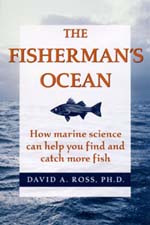The following excerpt is from the book The Fisherman’s Ocean by David A. Ross, Ph.D. Reprinted with permission from Stackpole Books, Mechanicsburg, Pennsylvania.
Fishing Tips Involving Smell
[dropcap]C[/dropcap]humming and bait-fishing are good ways to capitalize on fish’s excellent sense of smell. Placing pieces of bait or a slurry of ground-up bait in the water can create a “scent track” in the water near your boat. Fish, if attracted to the scent track, will follow it back to its source-your boat. A key to making this technique work is keeping the scent track continuous, which requires continual chumming, even when you’re fighting or landing a fish. Also, the scent track must be established in moving water so the scent is dispersed. Mix the chum with sand to reach deeper water.
Another way to capitalize on the scenting ability of fish is to add a piece of bait to an artificial lure. Live and fresh bait produce better scent than frozen bait or chum. People who fish for bonefish know this trick and frequently add a piece of shrimp to their lures. Most big game fish are visual feeders, but scent can be the initial attractant. Fish need time to detect a scent, and a slow-moving lure or fly may give them time to do so, whereas a rapidly retrieved lure or fly often will not.
The Sense of Smell
Many fish have a sense of taste, but scientists have not studied this ability as intensively as they have other fish senses. Most fish have taste sensors within their mouth; however, species such as catfish have external sensors or taste buds, called barbels, on their lips.
As I mentioned earlier, in many cases it’s difficult to know which sense a fish is using, smell or taste. A few species, again catfish and some sea robins, clearly use their sense of taste in their search for food. Sea robins have many taste sensors in their three pairs of pectoral fins, which they use to “walk” on or dig into the ocean floor.
Rejection?
Fish often use their sense of taste to test the quality of food they’re chewing. Some researchers believe that fish can discriminate between the tastes of sweet, salty, acidic, and bitter substances. Experiments have shown that fish will reject rotten or poisoned food; either the texture of the food or its taste may cause that rejection. Taste can also influence how a fish reacts when it takes a fly, which may be one of the reasons a fly is quickly rejected if the fish is not immediately hooked.
In summary, it’s clear that the sense of smell and taste play important roles in a fish’s search for food, in some types of migration, in the reproduction process, and in various types of communication between fish. Still, much remains to be learned about how fish detect and react to certain chemical stimuli and how these processes might influence our fishing methods.



